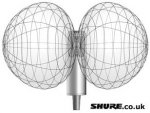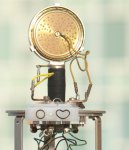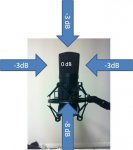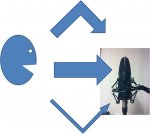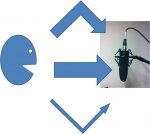dyce obviusly you know best you know more than anyone else
I didn't say that.
I never said "I know best"...
...nor did I say "I know more than anyone else"...
I said "I speak of what I know".
(and, in this case, I do know more than you, in particular)
and in fact your so wrong on things its doing my head in its like talking to a politician..
soundwaves do travel in straight lines the reason you can hear sound from different directions is the fact it bounces of objects before it hits you if it doesnt you can pinpoint the direction a sound comes from much easier if someones behind you you hear the sound from behind not from the front ..so you think about it !!
sound waves are directional, but they do not travel straight like a laser beam or a bullet...
they come from their source and are dispersed and diffracted and reflected...
(they disperse in a manner not unlike the spray bottle example)
The molecules vibrate... and those molecules, in turn, cause other molecules to vibrate... and they continue to collide and cause the adjacent molecules to vibrate, progressively weaker, until all energy is lost... and you hear "sound"...
Sound reflects off of surfaces which allows you to pinpoint directionality (along with the time variance from left to right ear), but the sound does not come out of your mouth in a pin straight line direct to the microphone.
if sound didnt travel in straight lines technology such as 5.1 wouldnt work as youd just have a mash off sound sound travels to you from the direction its coming from so if a right speaker is too the right of your head you know its coming from the right if sound doesnt travel in straight lines as you state then 5.1 encoding wouldnt work would it?think about that one einstein.
Sound from the 5.1 speakers is "directional" but does not shoot out of the speakers like a laser beam.
The sound "fans out", so to speak.
you obvioulsly think you know more than anyone else because you cant understand or even comprehend that i may be right and you may be wrong.same wit you you dont know what tracks ive worked on how long ive been doing this or anything else ive done i too could brag and brag about things but a forum like this doesnt need that crap
Actually, I do not even know what you are trying to argue with me about...
I do not know why you are bringing any of this up since none of it relates to my point: That an upside-down mic sounds no different from a rightside-up mic if you are pointing at the capsule at the same direction.
...and i do not care what tracks you have worked on or anything else you have done.
I did not bring that stuff up.
You did.
You are the one who said it was "arrogant" of me to question something your mentor said.
I only went on to say that:
1. there is nothing wrong with questioning people, and, in fact, it is a smart thing to do.
2. you are talking about your mentor having all this experience and me just being "some guy on a forum" when you don't even know what my credentials are... and that it shouldn't matter anyway.
if you want proof read this ..
http://www.ndt-ed.org/EducationResources/HighSchool/Sound/interference.htm
the part too read is the (Sound Traveling Between Materials)section.
now if after reading that you still dont believe sound travels in straight lines then join steven hawkins for dinner.
OK... I looked at your link...
Although the section you linked to does not really relate to what you were trying to say, I looked a the rest of the site you linked and found something that does directly answer this question:
What Is Sound and How Does It Travel?
"Sound is a pressure disturbance that moves through a medium in the form of mechanical waves. When a force is exerted on an atom, it moves from its rest or equilibrium position and exerts a force on the adjacent particles. These adjacent particles are moved from their rest position and this continues throughout the medium. This transfer of energy from one particle to the next is how sound travels through a medium. The words "mechanical wave" are used to describe the distribution of energy through a medium by the transfer of energy from one particle to the next.
Waves of sound energy move outward in all directions from the source. Your vocal chords and the strings on a guitar are both sources which vibrate to produce sound waves. Without energy, there would be no sound."
Notice it essentially says exactly what I said earlier.
I could show you other links that say the same exact thing, but what could be better than the same source that you thought so highly enough of as to link to it yourself?
anothe thing before i go get my dinner if sound doesnt travel in straight lines then bats wouldnt be able to fly or hunt..sonar wouldnt work...etc ..sound has to travel in a straight line for it too be bounced back too the bat or sonar if it didnt a bat couldnt hunt or detect were its prey is..
If you read up a little on bats and sonor/echolocation (I started writing a bunch here, but it is just easier for you to look it up), you will see that this is not something that "disproves" sound waves moving outward from a source.
---------- Post added at 04:19 PM ---------- Previous post was at 04:00 PM ----------
another thing if your a enginner or producer or whatever and youve been to uni/college one of the first lessons i got taught was how the ear percieves sound and altough sound travels in lines the ear doesnt listen in straight lines if it did youd never hear what was at the front or at the back off you.
the ear acts as a funnell gathering all soundwaves, it then channels that information down the ear canal were your mind then process the information into a kind of 3d spacial diagram of the outside world .
its a trait all sucessful predators have ,to survive our bodys had to adapt to think spacially if we didnt there wouldnt be humans here now we needed spacial awarness to hunt sucessfully we needed to hear were our prey was not just see were it was and also we needed to hear were other preadators were thats why our ears dont hear in straight lines..
and also the workd soundwave means the actual sound is a wave but how it gets projected is via straight lines..lesson over
So you think that somehow the "sound travels in straight lines" but the "ear doesn't listen in straight lines" so the ear is magically sucking is sound waves from all over?
The sound waves have to hit the ear for them to be heard.
The ear is like a funnel... animals use their big ears to focus the sound inorder to hear more effectively...
But, like a "funnel", the sound has to actually hit the funnel...
Just like if you were using a funnel to fill a jug with water... you need to pour the water onto the funnel in order for the funnel to direct the water into the jug.
If you pour the water 5 inches to the left of where the fullel is, no water will get into the jug. The funnel does not suck water into itself from all around... it takes what is poured into its wide opening and focuses it into the smaller outlet.





